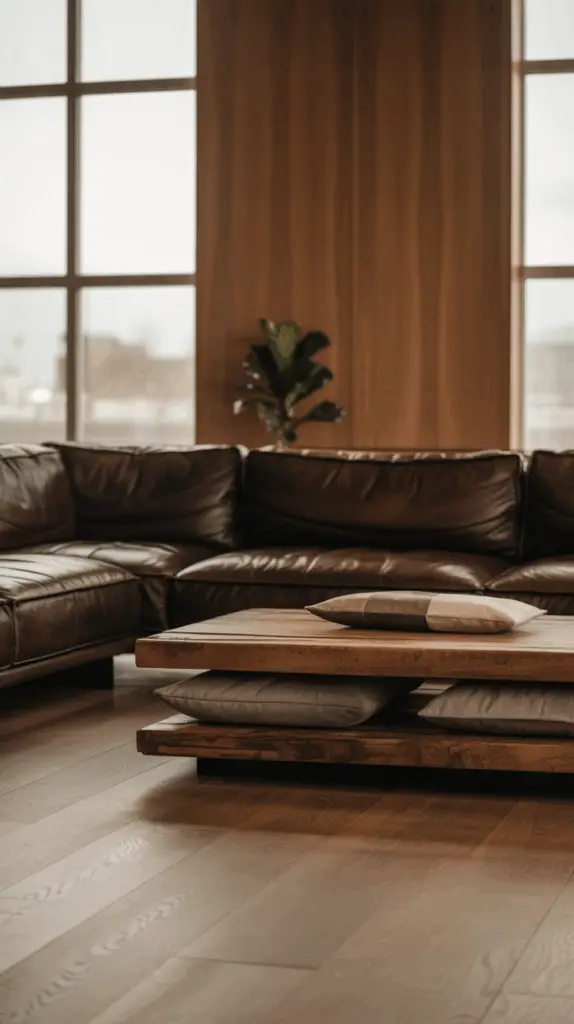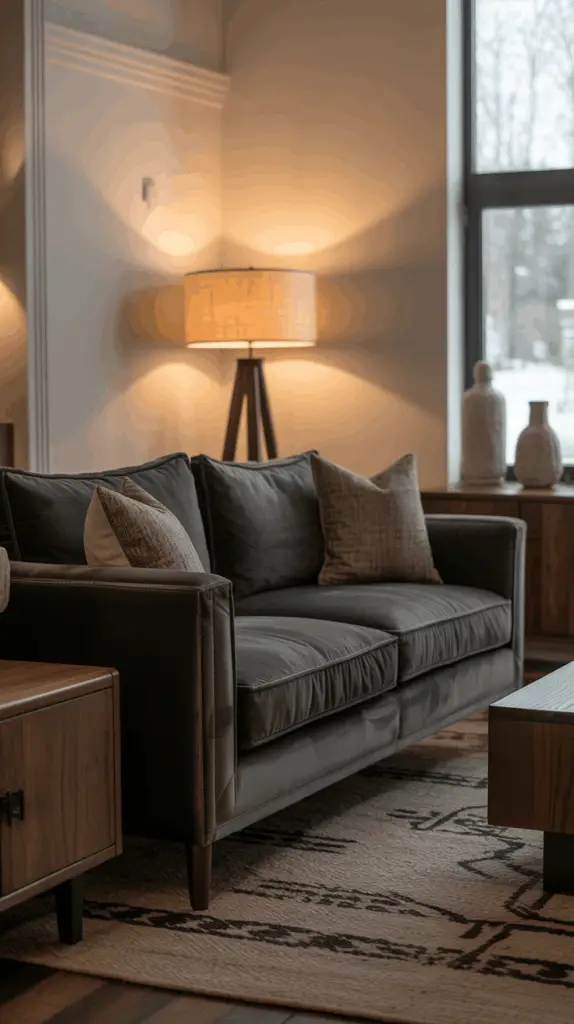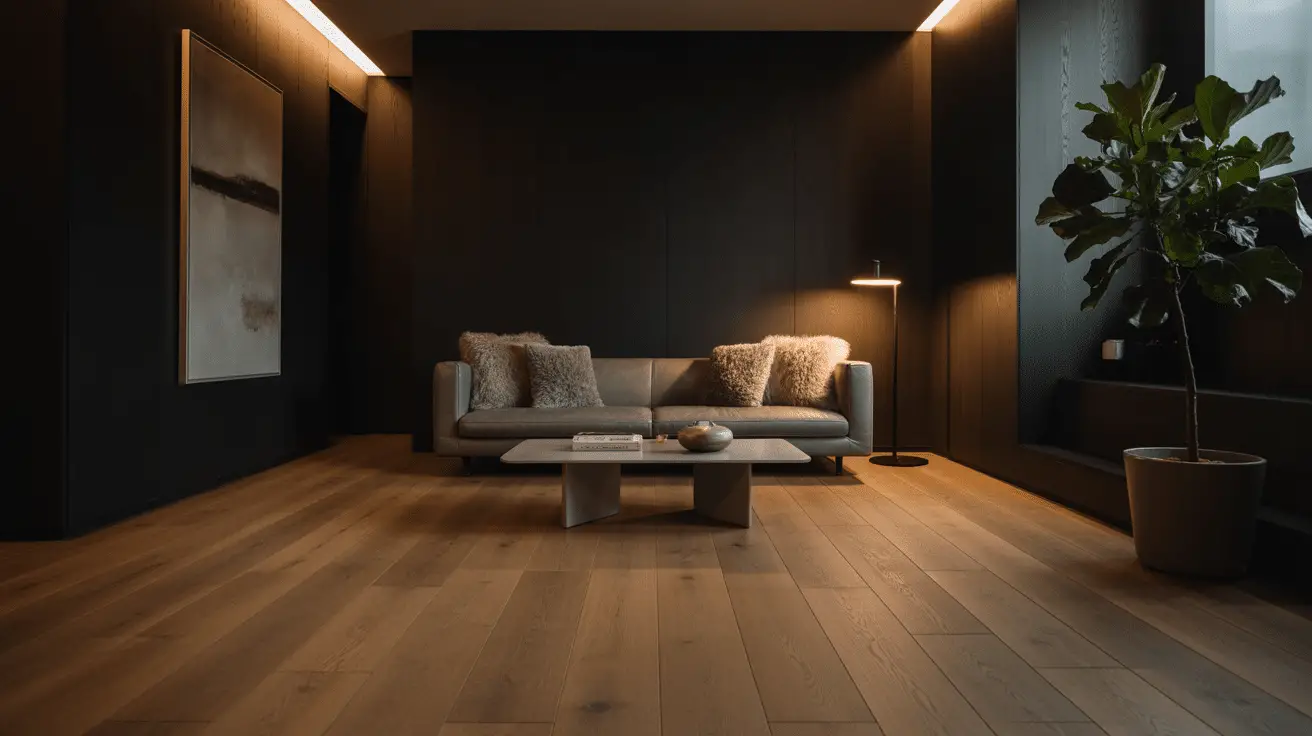Transform Your Space with Black and Wood Living Room Styling: A Guide to Modern Elegance
Table of Contents
Introduction
Few combinations in interior design capture balance and sophistication quite like black and wood. Together, these elements create a timeless harmony—where sleek modernity meets natural warmth. According to 2025 home décor trends, black interiors have seen a 40% rise in popularity, particularly when softened with natural wood accents. This pairing delivers contrast, depth, and coziness all at once, making it ideal for both minimalist and luxurious homes.
Black adds boldness, grounding your space with definition and drama, while wood infuses organic texture and light. When styled thoughtfully, the two work like yin and yang—complementing each other in tone, feel, and personality.
In this guide, you’ll learn how to master black and wood living room styling through smart color balance, furniture selection, lighting design, textures, and accents. Whether you’re after Scandinavian simplicity, mid-century elegance, or industrial chic, these ideas will help you design a space that feels polished, cozy, and undeniably stylish.
Balancing Black and Wood: The Art of Contrast
Creating the perfect black and wood living room starts with understanding visual balance. Black absorbs light, making it a strong design anchor, while wood reflects warmth. Striking the right ratio between these two tones determines whether your room feels cozy or heavy.
Start by deciding which element will dominate. If your living room receives plenty of natural light, you can safely use black on larger surfaces—like accent walls, cabinetry, or furniture. In darker spaces, emphasize wood as the primary tone and let black play a supporting role through fixtures, trim, or décor pieces.
To avoid visual flatness, incorporate multiple wood tones. For example, a walnut coffee table can pair beautifully with oak flooring and a black leather sofa. Mixing textures helps black elements feel more integrated rather than stark.
Table: Balancing Techniques for Black and Wood Interiors
| Design Element | Primary Focus | Supporting Accent | Resulting Mood |
| Dark walls + light oak | Black | Warm wood | Modern and bold |
| Walnut furniture + black trim | Wood | Black | Balanced and inviting |
| Black furniture + maple floors | Black | Wood | Contemporary minimalism |
| Charcoal textiles + rustic beams | Black | Wood | Cozy sophistication |
Choosing the Right Furniture
Furniture sets the tone for your black and wood living room, acting as the bridge between design and comfort. Choose pieces that highlight clean lines and craftsmanship. Black furniture, such as a leather sectional or matte-finish shelving, creates a strong base. To soften the look, introduce wooden pieces with visible grain patterns and warm undertones.
Mixing finishes is key. A black coffee table with a walnut top, or wooden side tables paired with metal legs, creates layers of texture. Avoid furniture sets that are too matchy—contrast builds character. Upholstery in charcoal, taupe, or soft beige complements the palette beautifully.
For balance, incorporate at least one statement wood piece, like a reclaimed console or mid-century chair. These become focal points that ground the darker tones around them.
Table: Furniture Pairing Ideas
| Main Piece | Complementary Material | Design Effect |
| Black leather sofa | Oak coffee table | Classic and sleek |
| Walnut TV stand | Black steel legs | Industrial edge |
| Charcoal armchair | Maple side table | Soft modern balance |
| Matte black bookshelf | Pine shelves | Scandinavian minimalism |

Layering Textures for Warmth and Depth
When working with a restrained color palette like black and wood, texture becomes your most powerful design tool. It prevents monotony and adds tactile richness to your space.
Combine smooth and rough finishes to create contrast. Think matte black walls paired with glossy ceramics, or rustic wooden furniture softened by plush wool rugs. Add fabric layers through cushions, throws, and drapery to enhance coziness.
For a modern look, focus on subtle texture shifts—brushed metals, linen upholstery, and polished wood grains. If your goal is a cozier aesthetic, mix tactile materials like boucle, jute, and faux fur. Each element should add visual movement without disrupting the cohesive palette.
Table: Recommended Texture Combinations
| Texture Type | Material Example | Design Impact |
| Soft | Wool, velvet | Adds comfort and warmth |
| Natural | Rattan, linen | Creates organic charm |
| Polished | Metal, marble | Introduces modern contrast |
| Rustic | Reclaimed wood | Adds authenticity and depth |

Lighting That Enhances Mood and Material
Lighting can make or break a black and wood living room. Because black absorbs light, thoughtful illumination ensures the space feels warm and inviting rather than dark or confined.
Layered lighting is essential. Start with ambient lighting—soft overhead fixtures or recessed lights that spread an even glow. Then, introduce task lighting through floor lamps or reading lights, and accent lighting to highlight artwork or architectural features.
Warm bulbs (around 2700K–3000K) enhance the golden tones of wood and soften black surfaces. Fixtures made from brass, smoked glass, or black metal fit seamlessly into the aesthetic. Consider wall sconces with wooden accents or pendant lights that create soft pools of illumination for intimate ambiance.
Table: Lighting Layer Breakdown
| Layer | Purpose | Fixture Example |
| Ambient | General illumination | Ceiling lights, recessed LEDs |
| Task | Focused lighting | Table or floor lamps |
| Accent | Highlighting décor | Sconces, strip lighting |
Incorporating Natural Elements and Greenery
A touch of nature brings vitality to a black and wood living room, preventing it from feeling too severe. Indoor plants add freshness and contrast against dark backgrounds while complementing wood’s organic warmth.
Choose plants with sculptural leaves—like fiddle leaf figs, snake plants, or monsteras—to stand out visually. Place them in neutral or textured pots, such as clay, ceramic, or woven baskets, that echo your color palette.
Incorporate natural materials in other elements too: jute rugs, stone vases, and linen curtains work beautifully. This combination not only balances the dark tones but also introduces tranquility and movement into the design.
Table: Natural Styling Essentials
| Element | Example | Effect |
| Plant | Fiddle leaf fig, snake plant | Adds freshness |
| Texture | Linen, rattan | Softens black tones |
| Accent Material | Stone, clay | Introduces earthy contrast |
Styling with Accents and Artwork
Accents and artwork bring personality to your black and wood living room. The goal is to add visual interest without overpowering the simplicity of your palette.
Start with metallic or matte black frames for wall art—these enhance cohesion while providing subtle sophistication. Artwork featuring neutral tones, abstract shapes, or nature-inspired themes complements the organic-meets-modern vibe.
Accessories such as throw pillows, ceramics, or books can incorporate muted accent colors like terracotta, ivory, or deep green to add depth. Mirrors framed in wood or black metal amplify light and expand visual space, making the room feel airier.
Table: Accent Styling Guide
| Accent Type | Material | Purpose |
| Wall Art | Abstract, botanical | Adds personality |
| Decorative Objects | Ceramic, brass | Creates texture contrast |
| Textiles | Cushions, throws | Softens and harmonizes palette |
| Mirror | Wood or metal frame | Reflects light and adds openness |
Creating Harmony Through Layout and Flow
Beyond color and material, the flow of your living room defines how comfortable and cohesive it feels. A black and wood design thrives on open, balanced layouts that highlight both contrast and continuity.
Position furniture to encourage conversation—sofas and chairs facing each other around a central wooden coffee table create intimacy. Avoid cluttering the space; black elements work best with breathing room around them.
Use rugs to define zones and guide movement, especially in open-plan spaces. Maintaining symmetry in lighting and furniture placement ensures your design feels intentional rather than chaotic. Remember, negative space is part of the aesthetic—it allows every texture, finish, and color to stand out gracefully.
Table: Layout Harmony Tips
| Design Element | Strategy | Result |
| Furniture | Center around focal point | Balanced composition |
| Rugs | Define conversation zones | Visual structure |
| Negative Space | Leave open areas | Sense of calm and airiness |
Conclusion
A black and wood living room is a timeless expression of balance—where modern sophistication meets natural comfort. When layered thoughtfully, these two elements transform an ordinary room into a space that feels grounded, elegant, and deeply inviting.
By balancing dark and light tones, layering textures, and incorporating warm lighting and natural accents, you can achieve a design that’s both visually stunning and emotionally comforting. Whether your style leans minimalist, rustic, or contemporary, black and wood offer endless possibilities for creativity and refinement.
When done right, this pairing becomes more than just a color choice—it’s a design philosophy that celebrates contrast, harmony, and the beauty of simplicity.

